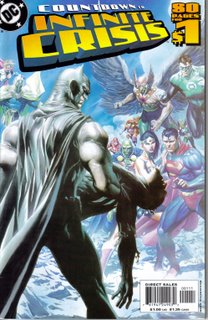
DC's major event of the year -- perhaps their major event of the decade -- has been Infinite Crisis, an 8 part mini series (if you count the 80 page COUNTDOWN TO INFINITE CRISIS that functioned as a prelude, which I do). Billed as a sequel to the near-mythical Crisis On Infinite Earths from 1985, designed to 'set to rights' a lot of continuity gaffes that have sprung up in the DC Universe since '85, this would normally not be a series I'd have the slightest interest in.
However, where Crisis On Infinite Earths was drawn beautifully by George Perez, and plotted/scripted appallingly by Len Wein and Marv Wolfman, and remains to this day (in my opinion, obviously) one of the single most wretchedly conceived and executed blots on the visage of superhero comics as a whole (other than its transcendentally lovely art), Infinite Crisis is being drawn, occasionally wonderfully, generally only capably, by the reasonably talented Phil Jiminez... and written by pretty much the only writer DC has I would not hesitate to hang the accolade 'brilliant' on... Geoff Johns.
That's made a huge difference. It was what got me to start buying the series, and it's what has kept me interested, over the course of the 7 issues that have appeared to date.
And the series started out beautifully, even brilliantly. In fact, although I am usually loathe to start reading new writers about whose work I know nothing, so good was the writing on Countdown that I resolved to check out the four different miniseries leading up to Infinite Crisis itself -- The Rann Thanagar War (which concerned itself with a lot of SF/interstellar storylines, featuring most of DC's space-based heroes and villains), Villains United (pretty much showing the formation of Lex Luthor's Society, a creepier, nastier, more grim n' gritty version of the rather goofy Silver Age Secret Society of Supervillains, and their ongoing conflict with a similarly new incarnation of the Secret Six), Days of Vengeance, a thing where all the supernatural heroes and villains got to do all this supernatural crap for six issues, and The OMAC Project, which pretty much followed DC's Big Guns (Superman, Batman, Wonder Woman, the rest of the JLA, for the most part) battling Batman's Project: OMAC gone berserk, which was in and of itself a tribute to an obscure mid 70s Jack Kirby concept named OMAC, the One Man Army Corps. All of these separate storylines would eventually be woven into the grand, universe shaking thread that was to be Infinite Crisis... and after reading Countdown, I was firmly on board for the whole trip, regardless of the fact that I had no idea who the writers on two of the four series (Gail Simone/Villains United, Greg Rucka/OMAC Project) were, and was unimpressed with what I knew of the other two (Bill Willingham/Days of Vengeance, Dave Gibbons/Rann-Thanagar War) as writers.
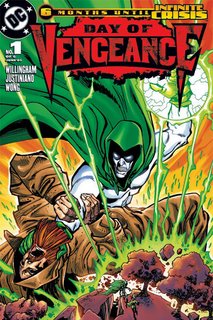
Each of the four lead in miniseries was, at the very least, readable. About the worst of them was Days of Vengeance. Any series featuring a team of obscure occult super-types called the Nightpact, led by Detective Chimp for the sweet love of Baby Jesus, is going to have some credibility problems at the very least. Given that the series was scripted by Bill Willingham, the guy who created The Elementals for Comico, I believe, I didn't expect much of it, and I didn't get much. Over the course of the series, the two most notable things I can remember happening were the Rock of Eternity blowing up, leading to the final death of the astral form of the seemingly immortal wizard Shazam, and the groundwork being laid for the creation of a new Blue Beetle character, who from what I've seen, is pretty much a waste of paper and ink, anyway.
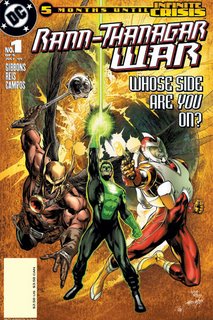
As to the other three, Rann-Thanagar War entertained me pretty well with each issue, but I'm goddamned if I can remember much of what went on in it now, mostly because it had to do with a lot of latter era Modern Age characters I really don't care about much, along with a few I'd personally enjoy seeing fed into a shredder, like Kyle Rayner and Blackfire. Tossed in with this were some old favorites, like Adam Strange, whom it seems clear I don't know anything about any more, because last I saw (back in the 80s) Alan Moore had revealed a great many things about Adam's back story that are, apparently, no longer true. I have no doubt many notable things happened during this miniseries as far as DC's space continuity are concerned, but writers and editors pay at most scant attention to such things; when some creator gets a wild hair up their ass and decides to do a space story at DC comics, they always tend to pretty much ignore everything that's been established previously about whatever characters they decide to write. It's been that way since time immemorial and I don't expect it to change, so the fact that I can't remember much of anything that happened in this series probably doesn't matter, since no one else will, either.
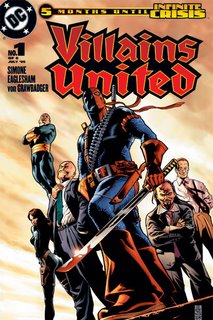
Villains United and The OMAC Project were the two IC lead in mini-series I enjoyed the most. The first was just straight up untrammelled Modern Age anti-heroics at its grungiest, and it hit all the lowpoints a Modern Age 'superhero' comic conceivably could -- explicit violence, cold blooded murder, torture, sex both straight and gay, blackmail, the most gruesomely detailed mayhem imaginable, even a very brief episode of cannibalism -- but no rape; ultra-feminist author Gail Simone refused to use the character Dr. Light in this series, reportedly because "he was now a rapist", which still strikes me as a strange double standard -- she'll write torture, she'll write murder, she'll write disembowelment, she'll write characters who use mind control and poison and acid and god only knows what the hell all else, she'll write Scandal Savage biting off someone's ear and eating it... but she won't write Dr. Light, because he's a rapist, and, you know, that's a particular form of violent assault she just can't get behind... some people are very strange. Still, I was fascinated to see the various machinations as the Society attempted to expand its numbers. I never much cared about any of the characters in the book, but it was interesting to watch everyone interact with each other, even if they were all scum.
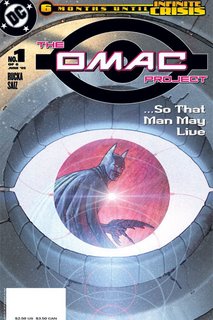 The OMAC Project was great fun to read; watching control freak Batman try to come to grips with the fact that his OMAC Project, which he had designed to covertly monitor all metahumans to keep them from getting out of hand, had gotten entirely out of hand, was vastly entertaining.
The OMAC Project was great fun to read; watching control freak Batman try to come to grips with the fact that his OMAC Project, which he had designed to covertly monitor all metahumans to keep them from getting out of hand, had gotten entirely out of hand, was vastly entertaining. 
And while I generally don't approve of lesser creators trying to reinvent Jack Kirby concepts (and they're all lesser creators than Mr. Kirby), still, this 'homage' was a pretty well done one.
All of that -- Countdown, Rann-Thanagar War, Villains United, Days of Vengeance, and The OMAC Project -- were just detailed build up to Infinite Crisis. Some of it was excellent, some if it was merely good, but given the general quality level, as I said, I was strapped in for the whole ride. And when Infinite Crisis itself finally began, it certainly didn't disappoint me. But the quality level dropped off steeply... or so it seems to me... with each passing issue. With one issue left, well, I can only say, at this point, I'm really not that impressed.

But... oh, that first issue -- !
We start out quietly enough, with the Big 3 -- Humanity's Greatest Heroes, at least, in the DC Universe, Superman, Batman, and Wonder Woman -- standing around in the wreckage of the JLA Watchtower, discussing their significantly different points of view and subsequent opinions as to exactly how each, and all, of them should proceed at this point, as what is obviously going to be a major crisis for humanity shapes up.
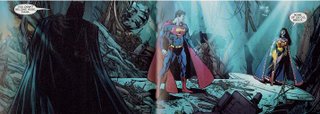
Our heroes are at odds, for various reasons requiring some backstory. Superman and Wonder Woman are pissed off at Batman, because it turns out Batman created Project: OMAC to covertly surveille all metahumans on Earth, including his fellow heroes, to make sure that so metahumans ever abused their power again the way his fellow Justice Leaguers did several years prior to this, when they erased Dr. Light's memories of raping Sue Dibney, and also erased the memories of all the JLAers (including Batman) who voted against doing it.
Batman is pissed off at Superman and Wonder Woman because of the above memory erasure -- he considers his mind to be his only real weapon and super power, so finding out his allies and trusted friends had tampered with his memory against his expressly stated will was a real betrayal. Beyond that, Wonder Woman has just (in her own series) cold bloodedly murdered Maxwell Lord, because it was the only way to free Superman from Lord's mind control. Everyone on the planet knows she did it, because Lord had hijacked control of Project: OMAC at the time, and Brother I, a covert surveillance satellite of Batman's design, recorded and broadcast the murder world wide. Batman, as you could guess if you knew anything of his background, has a little problem with cold blooded murder of any sort, regardless of any justifying circumstances.
Wonder Woman is pissed off at Superman because of the memory erasure thing, which she would have voted against if she'd been a member of the League at the time, and she's pissed off at Batman over the OMAC thing, and she's generally feeling defensive and unloved because everyone is down on her over the murdering Maxwell Lord thing, even though Lord had complete mental domination over Superman and had ordered Superman to kill Wonder Woman, and he was pretty close to succeeding at the time, too. Lord himself, under the control of Wonder Woman's magic lasso, had told her that the only way to release Superman from his control was to kill him. Yeah, she had no idea she was doing it on live worldwide TV, and her act has badly shaken humanity's faith in its heroes because none of them know the circumstances surrounding it, but she really thinks her fellow heroes should be a tiny bit more understanding.
Superman is pissed at Wonder Woman because, you know, he has a little problem with murder, too, and the second largest sequoia-sized stick up his ass regarding moral issues in the entire DC Universe. (Batman has the biggest one, no contest.)
So they're all pissed off at each other, because things are going to hell in a handbasket really fast. Some mysterious entity has destroyed the JLA's lunar base and done something unknown to the Martian Manhunter, who was on duty at the time. There's an interstellar war going on that a third of Earth's heroes have decided to go off and fight in, there are weird OMAC things attacking superhumans everywhere for no known reason, and all the supervillains on the planet are organizing into their own evil Society... and something's going wrong with magic, too, although none of them have more than a vaguely uneasy notion as to that.
Naturally, they need to get together to jaw things over. I have no problem with this; in fact, I, like Richie Howell, love little more than seeing my favorite fictional characters stand around and interact, when they're being written well. Johns is a wonderful writer, so I would have liked nothing better than to watch Bats, Supes, and WW stand in the wreckage of the Watchtower and yak for 20 pages or so. However, editors do not trust Modern Age fans to be able to focus on talking heads for longer than a couple of pages, max, without getting bored and heading for the X-Box, so an obviously editorially mandated, and otherwise absolutely pointless, battle with Mongul is thrown in. (The only good thing about the fight is that it's probably an ass backwards homage to Moore's "For The Man Who Has Everything", a story in which Superman, Batman, and Wonder Woman all have to fight Mongul in Superman's Fortress of Solitude -- something that I'm pretty sure no longer even exists in the Modern Age DC Universe.)

Meanwhile, we discover that four mysterious figures are watching everything that is happening from some detached, omniscient vantage point -- and apparently, they aren't happy with how things are going.
"His jaw clenches as he opens his shirt. For a moment, I see the man he could be instead of the boy he believes he is."
"But sadly, only for a moment."
Beautiful stuff. And this first issue is only getting started. A few pages later, Nightwing gets a look at the fruits of his mentor's genius --
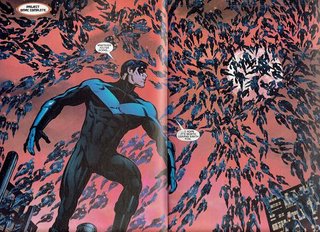
-- a million OMACs blotting out the sky.
From there we go to a double page spread featuring a lot of characters few if any of us care about way far away in space somewhere, looking at this gigantic rift in the very fabric of space/time. Kyle Rayner, Adam Strange, Guy Gardner, L.E.G.I.O.N. (who I was a little shocked to see still existed, but whom I still don't give a shit about) and the Guardians all talk about weird cosmic phenomena that none of them understand and try to make us feel like we care. Yawn.
Then we see a couple of pages detailing the chaos that currently reigns in Gotham City, as a soulless Spectre rampages across the face of the planet destroying every magic user it can get its hands on, releasing long bound demons in the process, and as the Society wages war on the forces of law and order, while a panicked citizenry riots in the streets. It's a beautiful page, and its central image, the projection of the Bat signal on the Spectre's chest, led me to conjecture in an earlier post that the new Spectre might well be Bruce Wayne.

It's a fabulous idea, one that makes perfect sense given Batman's obsession with vengeance and with punishing the guilty... but alas, we have since then learned that the new Spectre will in fact be some dead black cop I'd never previously heard of, because, you know, DC wants more minority characters, it just doesn't want them to be anywhere anyone will have to really pay any attention to them.
From here we go to IC #1's most viscerally hard hitting moment. It starts with the following panel:
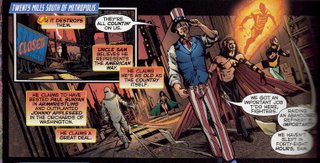
From left to right: The Human "My Superpower Is To Blow Up Real Good! Yes! Honest To God!" Bomb, The Phantom "Take A Good Look At These Hooters, Boys, You Don't See Gazongas Like This Every Day, And They're All Real, Too" Lady, Uncle Sam, the embodied fighting spirit of the U.S.A. his damn self, Black "I Have The Power To Fly! Plus I'm A Frickin Comanche Or Some Shit!" Condor, the Modern Age version of The Ray, because the Golden Age version was smart enough to die and get the hell out of this Hoser Brigade, and Damage, another Modern Age character who had his own series back in, I don't know, the late 80s or something, and it failed so spectacularly that DC felt they had to do something really really bad to the poor guy, so they stuck him in with these schmoes.
That's the Freedom Fighters you're looking at, and a bigger bunch o' goobers ye've never seen, fella-me-lad. Originally thrown together for a not-short-lived-enough series back in the 1970s by relentless comic book hack Marty Pasko, the Freedom Fighters were, back in the Golden Age, a bunch of not particularly auspicious characters published by Quality Comics. When Quality went bankrupt sometime in the 50s, DC bought the rights to all their material. Pasko got the nod to try and use some Quality characters in an ongoing series, and came up with the brilliant idea of organizing these rubes into a sort of All-Weiners Squad whose exploits were set on Earth-X, a world where the Axis had won World War II.
A better writer might have done something with it, but Marty Pasko admits superiority to no mortal born; in the rotten comics writers sweepstakes, even veteran hacks like Gerry Conway, Tony Isabella, and Elliot S! Maggin have to shrug haplessly and step aside for the Man Named Marty. The series was appalling; worse, even, than skludge like Tony Isabella's Black Lightning and the nearly infamous Brother Power The Geek. It stunk up the spinner racks for less than a year, I believe, before being mercifully canceled and consigned to oblivion.
Since then, we've occasionally seen these wretched losers cluttering up the backdrop of various different stories in various different issues of various better characters' series. I've never liked them, and I don't think anyone else ever much did either, but it's a tribute to Geoff Johns' writing ability that in two pages following this panel, he actually manages to make me at the very least kind of empathize with the guys, and start to actually regard them as being something kind of approaching real, and sympathetic, if not exactly cool or even remotely worthy of respect.
And then the poor dumb bastards opened the wrong door.
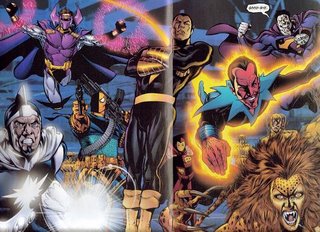
You've heard the phrase "it's all good"? For the Freedom Fighters, this is all bad. From left to right, that's Dr. Light, Zoom, Dr. Polaris, Deathstroke the Terminator, Psycho Pirate, Black Adam, Sinestro, Bizarro, and Cheetah... shock troops for the Society, here to kill them a few useless superheroes. Now, Dr. Light's a twit, and Dr. Polaris is a pretty big loser too, and I personally think Sugar & Spike could probably outwit that dimbulb Deathstroke. Psycho Pirate's a lightweight and Cheetah ain't such a much, either; the Freedom Fighters could probably take her, or any of the other four, and maybe all five of them. But Black Adam, the bad ass version of Captain Marvel, Earth's Mightiest Mortal? Christ in a leaky rowboat, this guy can take most of the Justice Society by himself, much less Team Dipshit here. Throw in Zoom, who is basically an evil Flash, Bizarro, who is essentially a crazy version of Superman, and Sinestro, the psychotic former Green Lantern, and you can practically here the Lord Humungous, Ruler of the Wasteland and Ayatollah of Rock and Rollah, somewhere in the background intoning through his scratchy PA system "I promise you -- NObody gets out of here alive."
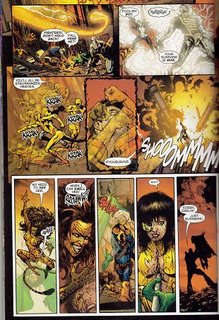 Uncle Sam tries to rally his troops, but as the page to the left clearly shows, the good guys are outmanned, outgunned, and shit out of luck. In the Golden or Silver Age, this would just mean they'd take a beating, wake up in some crazy-ass death-trap, and have to escape in the next issue. Here in the Modern Age, though, the bad guys can and do kill... and even a hero -- or a heroine... can die.
Uncle Sam tries to rally his troops, but as the page to the left clearly shows, the good guys are outmanned, outgunned, and shit out of luck. In the Golden or Silver Age, this would just mean they'd take a beating, wake up in some crazy-ass death-trap, and have to escape in the next issue. Here in the Modern Age, though, the bad guys can and do kill... and even a hero -- or a heroine... can die. 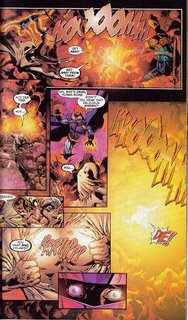
In the end, though, the Freedom Fighters are helpless...
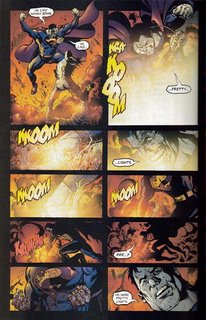
...hopeless...
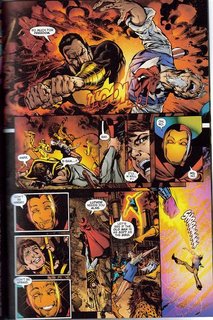
...and other than the two Modern Age members, whom DC probably figures they can do something with sometime...
 ...lifeless.
...lifeless. The death of the Freedom Fighters was like a punch in the gut. Yeah, this series was billed as the sequel to Crisis On Infinite Earths, and yeah, the first Crisis certainly had a body count. The Silver Age Flash and the Silver Age Supergirl both died 'heroically' in the events of the Crisis... but their deaths were impersonal. They died fighting cosmic forces, they were killed by energy vortexes and other wildly unlikely shit. And those death scenes were monumentally overwritten by one of comicdom's biggest and most histrionically hammy hacks, Marv Wolfman. Even with Perez drawing tears running down every superhero in existence's cheeks as a weeping Superman held his cousin's broken, battered body up in his arms, all I could feel was anger that a character I'd liked as much as I did Supergirl had been chosen to get hit with the mortality stick, while all those rotters in the New Teen Titans and goddam Infinity Incorporated came through it without a scratch.
There was nothing impersonal about the deaths of the Freedom Fighters. Dorks though these guys may have been, they were characters who went back to the Golden Age of comics, characters who had been around forever, character we all knew and, if not loved, or even liked much, still, we accepted them as an unchanging part of the superheroic backdrop. Just as we accepted that supervillains might strive mightily to kill the heroes, but they would never actually succeed. Yet here, the heroes were overmatched from the start, and instead of fighting back bravely and somehow, against all odds, managing to triumph against overwhelming evil... they just died. Their deaths were brutal and vicious. Their killers, for the most part, walked away unscathed. And if the death scenes in the first Crisis had been written by someone who played his keyboard like Captain Hook on crack cocaine, this particular sequence was scripted by the comic book writer's equivalent of a Beethoven or a Mozart.
More than a gut check, it was a reality check. More than anything, the deaths of the Freedom Fighters served notice -- this wasn't the old days any more. All bets were off, as were the kid gloves. Worlds would live, and worlds would die -- and so would characters you thought were unkillable.
And even then, Johns wasn't done with us. We had one last big, brilliant, brain-busting plot twist left. Remember those four people we saw watching everything from somewhere far above, talking about how much they hated how things were going?
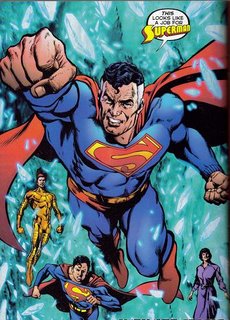
If you don't know anything about DC's Silver Age continuity, if you never read the first Crisis, then the page above means nothing to you. You won't recognize the Earth-Prime Superboy, the Earth-3 Alexander Luthor, the Earth-2 Lois Lane... or the Earth-2 Superman. The Golden Age Superman. The original Superman, the first superhero ever... faster than a speeding bullet, more powerful than a locomotive, able to leap tall buildings at a single bound... that Superman. You wouldn't have gasped as you realized that, after all, Johns wasn't kidding, and this really is a sequel to the first Crisis, because the first Crisis ended with all these characters drifting off into some strange white light together, presumably never to be seen again, as they had no place in DC's brave new post-Crisis world... and yet, here they were again. They were back... and they were determined to save the day.
Man, what a mind blower.
I was psyched to get the next issue of Infinite Crisis. How in the world could Johns ever top this?
Unfortunately, he didn't. I couldn't know it then, but this issue was the best this mini series was ever going to be. Infinite Crisis was on the downhill slope. It was descending slowly... the second issue would be nearly as good as the first... but the decline, the decay, would rapidly accelerate. The rot was in the wood. It just wasn't showing yet.
And we'll see the beginning of the badness... in Part II.


No comments:
Post a Comment